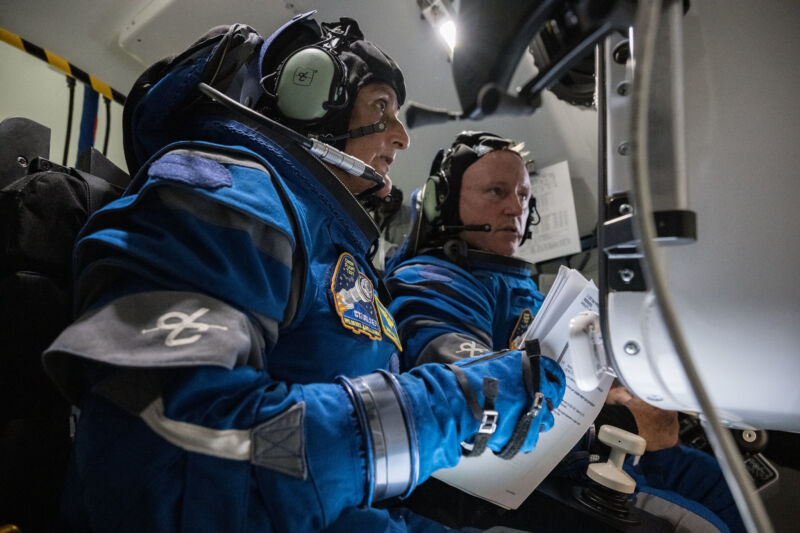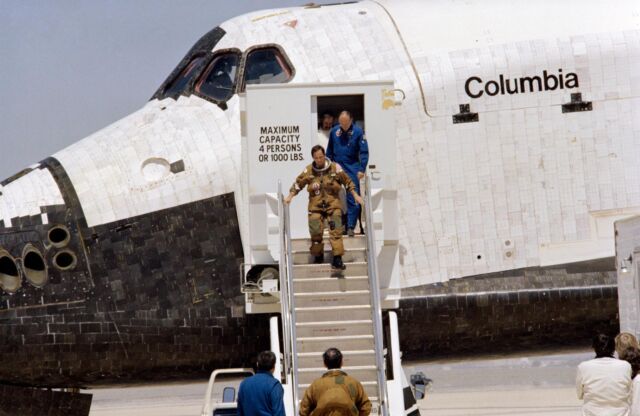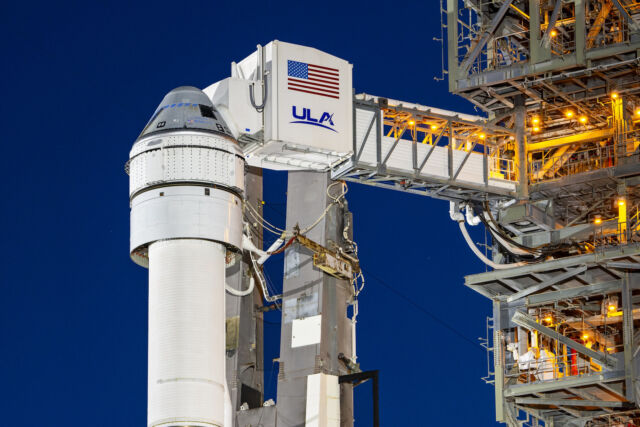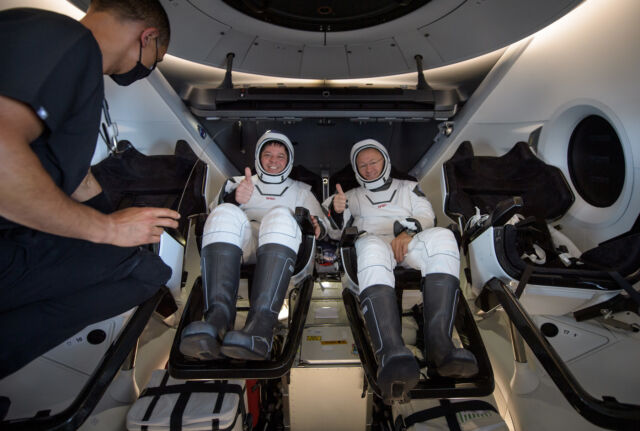
If you want to know what it's like to take a new spacecraft on its first test run in orbit, there are only three people in the Western world you can call.
That fact should drive home the rarity of debuting a new human-rated spaceship. When Boeing's Starliner capsule lifts off Monday night, this group of three will grow to five. Veteran NASA astronauts Butch Wilmore and Suni Williams, both former US Navy test pilots, will be at the controls of Starliner for the ride into low-Earth orbit atop a United Launch Alliance Atlas V rocket.
“The first crewed flight of a new spacecraft is an absolutely critical milestone," said Jim Free, NASA's associate administrator. "The lives of our crew members, Suni Williams and Butch Wilmore, are at stake. We don’t take that lightly at all."
After liftoff from Cape Canaveral Space Force Station in Florida, Wilmore and Williams will monitor Starliner's systems and take over manual control for a few piloting tests as the spacecraft autonomously approaches the International Space Station. Assuming the launch happens Monday night, docking at the space station is scheduled for early Wednesday. Starliner will remain in orbit at least eight days, with the earliest opportunity to undock and land set for May 15.
“It’s a test pilot’s dream—everything we’re doing from start to finish," Wilmore said.
If you start the clock from the day Boeing announced the Starliner program in 2010, this moment is running nearly 10 years behind the company's original schedule.
"It’s a little bit of an emotional roller coaster as things were getting fixed, or you see a couple steps back, but then you see a couple steps forward," Williams said. "We're at that point now. We knew we would get here eventually. It's a solid spacecraft."
A test pilot’s dream
Wilmore, 61, is a native of Tennessee. He will take the left seat in Starliner's cockpit as the commander of the Boeing test flight. Williams, 58, grew up in Massachusetts and will serve as Starliner's pilot. Both astronauts have flown to space twice before and have launched and landed on the space shuttle and Russian Soyuz capsules.
AdvertisementThey are set to join a small club of astronaut test pilots who have hands-on experience piloting a new type of spacecraft in orbit for the first time. Astronauts Doug Hurley, Bob Behnken, and Bob Crippen are the only three Americans alive who can make that claim. Hurley and Behnken flew on the first astronaut mission on SpaceX's Dragon spacecraft, and Crippen piloted the first space shuttle mission in 1981 alongside commander John Young, who died in 2018. Yang Liwei, the first astronaut to fly on China's Shenzhou spacecraft in 2003, rounds out the global club.
Ars spoke with Hurley, Behnken, and Crippen in the days before the first crew flight of Boeing's Starliner spacecraft.
"It's a unique opportunity to get to fly a brand-new spaceship, which is awesome," Hurley said. "Those don't come around very often."
Hurley and Behnken retired from NASA's astronaut corps after their 2020 mission and now work for Northrop Grumman and Lockheed Martin. Crippen, now 86, left the agency in 1995 after a stint as director of the Kennedy Space Center in Florida.
This will be the first time anyone has ever flown on Starliner, and the first crew launch aboard an Atlas V rocket. The Atlas V's 99 previous flights have all lofted satellites or deployed NASA probes heading into deep space. Hurley and Behnken's flight with SpaceX in 2020 was on the 85th launch of a Falcon 9 rocket.
Crippen's experience was vastly different. The space shuttle never launched without people in it, and the first flight of Columbia, known as STS-1, might have been the riskiest mission ever undertaken by NASA. In retrospect, NASA officials calculated there was a 1-in-12 chance that a catastrophic failure on the STS-1 mission could have killed the crew.
"Butch and Suni are going up on the Atlas V, which is a pretty reliable booster, whereas John and I had a completely experimental spacecraft," Crippen said. "They both are very experienced astronauts, and they're well-qualified to do this."

Crippen met with the Starliner crew at the space center in Florida a few months ago, when he got a chance to see the Starliner spacecraft up close. “Seeing it reminded me a lot of the command module we had from Apollo," he said.
The first Starliner crew has trained together nearly four years. Wilmore replaced the mission's original commander in 2020, and Williams has been assigned to the Boeing commercial crew program since 2018.
"My advice is know the spacecraft as well as you can," Crippen said. "I think they're well prepared. They've had a considerable amount of time ... with the delays they've had."
A different experience
Wilmore and Williams will each take a turn at the controls of Starliner once the capsule is in orbit. In the first few hours after liftoff, the astronauts will check that they can fire thrusters to point Starliner's rear-mounted solar array toward the Sun to generate electricity. Starliner has two hand controllers for the crew to control the orientation of the spacecraft, along with cockpit displays reminiscent of the flight of the space shuttle. The touch and feel of the Starliner cockpit displays are starkly different from SpaceX's Crew Dragon, which primarily employs touchscreen controls for manual flying, along with a single row of buttons to execute commands and perform emergency functions.
Bob Hines, a NASA astronaut who launched to the space station on a SpaceX Dragon spacecraft two years ago, was aboard the orbiting research lab when Boeing's Starliner arrived for its first docking. He is one of the few astronauts who has been inside a Dragon and Starliner in space.
"There's a pretty stark contrast between the two," he told Ars. "Dragon feels a little bit bigger. That's probably just because it's a different shape."
Both spacecraft are designed to ferry four people to and from low-Earth orbit, and if everything goes according to plan, both fly autonomously. Starliner, like Dragon, will normally dock with the space station in autopilot mode. Dragon splashes down in the ocean under parachutes, while Starliner will parachute to a landing on the ground, likely at White Sands, New Mexico.
"The general philosophies for what the crews' roles are in the vehicle are a little bit different," Hines said. "Starliner is an incredibly capable vehicle. Even if they lose communication, they can complete an entire rendezvous and docking with no communications if they need to, if the flight rules allow it. SpaceX is primarily controlled from Hawthorne (SpaceX mission control) from the ground, so they're very reliant on having communications, and they have a very robust system between the ground and tracking and data relay satellites. They're able to do that."
On their Starliner test flight, Wilmore and Williams will be the eyes and ears for astronauts who will fly on the Boeing capsule in the coming years. Sensors recorded accelerations, vibrations, and sound throughout the first two Starliner test flights. Now, Wilmore and Williams will test the human experience.
AdvertisementIn a press conference leading up to the Starliner test flight, Ars asked Wilmore about the sensations he expects to feel riding on Atlas V and Starliner during launch.
"Vibrations? No idea. Looking forward to it," he said. "The engine, the RD-180, will throttle down to not exceed three-and-a-half Gs on launch. It’ll be a different sensation. The shuttle flight that I flew, compared to the Soyuz, was completely different. We’re looking forward to finding out what those physical sensations are."
SpaceX's Crew Dragon demonstration flight in 2020 was nearly flawless. The only real surprises, according to Hurley and Behnken, were some of the sensations and sounds they experienced while inside the spacecraft.
"The big thing that stood out for us was when we separated from the trunk just before reentry," Hurley said. "It felt like a giant 2-by-4 hit the back of our seats. I may have let out an expletive when that happened, like, 'Holy cow, what was that?!' I looked over at Bob, and the look on his face showed the same thing, even though he didn't say it."
For Behnken, one of the biggest surprises was the sound of venting and valves moving on the Falcon 9 rocket during the countdown.
"When we fueled up and the launch escape system was armed ... there was a kind of a significant sound and jolt, and the timing when you send computer commands to when valves actually move and do reconfiguration, and the sounds that go along with that, was a bit of a surprise to both of us," he said in an interview with Ars.
"We’ve been forewarned about a couple of different things on the launch pad as valves are moving; you might hear a little boom here or there as they’re priming valves," Williams said. "We’ll be ready as much as we can be."
A distant second
From the outside looking in, there is a bit of an anticlimactic feel to the launch preparations for Starliner. Four years ago this month, SpaceX launched the first crew mission aboard the Dragon capsule, ending a nine-year gap in US capability to put its own astronauts into orbit.
Boeing and SpaceX started their commercial crew programs at about the same time. In September 2014, NASA's commercial crew program awarded Boeing a $4.2 billion contract and SpaceX a $2.6 billion contract to complete development of the Starliner and Crew Dragon spacecraft.
Both companies encountered delays, but SpaceX reached the finish line first with the flight of Hurley and Behnken on Crew Dragon. This was the first debut of a new class of American spacecraft since the first flight of the space shuttle in 1981, with astronauts John Young and Bob Crippen onboard.
SpaceX's first astronaut mission took on added significance because it restored independent human spaceflight capability to the United States for the first time since the retirement of the space shuttle in 2011. Also, launch of the Dragon spacecraft's Demo-2 mission in 2020 occurred about two months into the coronavirus pandemic. A lot of people were stuck at home, and for many, this giant leap forward for America's space program was a welcome respite.
Fast-forward four years, and SpaceX has launched 13 astronaut missions on its fleet of Dragon capsules. Crew Dragon missions are launching at a cadence similar to the rate that the space shuttles launched in the final years of that program, rotating NASA crews to and from the International Space Station and pioneering a series of all-private human spaceflight missions.

Early on in the commercial crew program, SpaceX, led by one of the most famous people on the planet, played the role of insurgent. It was the startup with the mission of shaking up the space industry. Boeing, one of the world's largest and oldest aerospace companies, could be the dictionary example of the space industry establishment.
Considering all of that, it's easier to understand why the first crew launch of Boeing's Starliner isn't getting the same fanfare as SpaceX's Dragon test flight. While it won't capture the headlines that SpaceX's Dragon test flight did in 2020, the first time astronauts fly to space on Starliner will be historic. Starliner will be the sixth human-rated spacecraft from the United States to fly astronauts into orbit, following NASA's Mercury, Gemini, Apollo, the space shuttle, and SpaceX's Dragon.
Once Starliner is up, the United States will have two independent orbital-class crew spacecraft in service at the same time. This has never happened before because all of NASA developed all of its previous crew ships in serial fashion, with no overlap in operations between each program. NASA officials say having two human-rated spacecraft is important because it will help ensure US astronauts always have a way to fly to the space station, even if SpaceX or Boeing ground their vehicles due to technical problems.
AdvertisementIt's also a pivotal moment for Boeing. Problems with the workhorse 737 airplane have put Boeing on the defensive, and the company's chief executive has announced he is leaving his post by the end of this year. The Starliner program, too, has been troubled. The spacecraft's first unpiloted test flight in 2019 ended prematurely due to software problems, and Boeing officials later admitted they did not run an end-to-end test of the capsule's flight software. There were several incidents with Starliner's propulsion system, including a significant propellant leak during a ground test in 2019 and corroded valves that thwarted an attempt to launch a second unpiloted test flight in 2021.
"SpaceX was first, and Boeing is a distant second," Hurley said. "There was enough blame to go around for that. Certainly, that first orbital flight test, they were lucky to get the vehicle back, if I'm being frank."
Last year, Boeing appeared to be closing in on a summertime launch of this crew test flight. But engineers discovered more problems that kept Starliner on the ground. These issues involved the capsule's parachutes and flammable tape inside the craft's cockpit. All of these delays cost Boeing more than $1.4 billion. Boeing was on the hook for the cost overruns because NASA's commercial crew program operates through fixed-price contracts.
Boeing and NASA officials say those problems are now behind them. "This is a clean spaceship, and it's ready to fly," said NASA Administrator Bill Nelson.
"I feel very excited and optimistic for them that they're at the point where they can finally do the crew test flight," Hurley said. "Certainly, I think they're more than prepared, from the crew standpoint, to execute the mission, and we just have to stay positive and optimistic that the hardware and everything else is where it needs to be, which by all indications it is."
Calculating risk
The risk of flying on new commercial crew capsules is relatively low compared to the 1-in-12 odds of a fatal accident on the first space shuttle mission. NASA set a safety threshold for the Crew Dragon and Starliner spaceships at 1-in-270 odds of an accident during a seven-month mission that would kill the astronauts onboard.
Before SpaceX's astronaut test flight in 2020, NASA determined the "Loss of Crew" (LOC) probability on a long-duration Crew Dragon mission was 1-in-276. NASA calculated the overall risk of a "Loss Of Mission" (LOM) on Crew Dragon at 1-in-60. That risk covers scenarios where the Crew Dragon doesn’t reach the space station as planned, but the crew safely returns to Earth.

For Starliner, the odds for a Loss of Crew on a seven-month mission are 1-in-295, according to Steve Stich, NASA's commercial crew program manager. The Loss of Mission risk number is 1-in-57.
Assuming the Starliner test flight this month goes well, NASA hopes to certify Boeing's capsule to fly long-duration missions to the space station beginning next year. On those lengthy missions, the top risk to the spacecraft and its crew will be potential damage from collisions with space debris or micrometeoroids, small fragments of rock and dust coming toward Earth from the Solar System. Other major risk factors include Starliner's parachutes and vehicle separation systems, he said.
Arriving at a specific probability for a catastrophic failure on any spacecraft hinges on assumptions, such as current understanding of the ever-changing space debris environment at the altitude of the space station. This makes it a challenge to settle on odds for a Loss of Crew or Loss of Mission.
These probabilistic risk assessments can change over time due to better data on the performance of a given rocket engine or other critical component. At the time of the first space shuttle flight, engineers calculated the probability for a Loss of Crew on that mission at between 1-in-500 and 1-in-5,000. NASA arrived at the 1-in-12 number after grounding its probabilistic model with flight data from actual shuttle missions. By the end of the shuttle program, after two fatal disasters, NASA calculated the risk of a Loss of Crew on any single mission was about 1-in-90.
Starliner and Crew Dragon improve these odds by having the capability to abort off their rockets and parachute into the ocean in the event of a launch failure. The only sure way for a shuttle crew to safely make it back to Earth was to fly the spaceplane back to a controlled landing at a runway.
AdvertisementWilmore and Williams are used to taking calculated risks.
“We wouldn't be sitting here if we didn't feel, and tell our families that we feel, confident in this spacecraft and our capabilities to control it and to be on it," Williams told reporters in March.
Before becoming an astronaut, one of Wilmore's assignments in the Navy was to fly the service's new T-45 training jet off of an aircraft carrier for the first time. When the catapult launched his aircraft off the deck, it didn't give the T-45 as much speed as expected. Wilmore nearly went into the water when the airplane launched off the end of the carrier.
"I went down to 16 feet above the water," he told Ars. "The aircraft carrier is 60 feet, so I settled 44 feet on the first one ... I was ready to pull the ejection seat handle if I thought I was to hit the water."
The Navy ruled out pilot error or a hardware problem with the aircraft or the steam catapult on the carrier. "The engineers, after checking all their data, what they found out is that they had done the equivalent of transposing a fraction."
That caused the catapult to operate at a wrong setting and almost put Wilmore and his T-45 into the sea. This was an example, Wilmore said, of what test flights are for.
"You don't know that until you test," he said. "So we may hit a cliff. In these various tests that we're doing, we may find something that is not right."
Williams is also a seasoned Navy test pilot with more than 3,000 flight hours in more than 30 different aircraft, primarily helicopters. She also served as the safety officer for the Naval Test Pilot School.
"Suni and I know this spacecraft, in an integrated fashion, better than anybody," Wilmore said. "There are people that know certain sections of it a lot better than us, but we know it better than just about anybody. We’ve been doing this a long time, and future crews are not going to have that luxury, so we want to find it all now.”



















